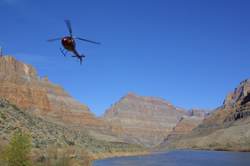
The National Park Service has released its proposed air tour management rules for the Grand Canyon. Key features of the plan include increased flight altitudes near North Rim overlooks, reducing flights in Marble Canyon, moving routes away from some key visitor use areas, and establishing an hour-long flight-free period for an hour after sunrise and an hour before sunset. This last change will be especially appreciated by backcountry hikers and river-runners, for it provides two hours a day of true extended natural quiet, at the times when the soft, rich light brings the canyons walls most subtly and dramatically alive.
The proposal caps nearly 25 years of work, initiated in the wake of a 1987 congressional mandate to come up with a plan that “provides for substantial restoration of the natural quiet and experience” of the Canyon. The proposal would allow slightly more flights than are currently operating, but would largely concentrate them in one long and one short flight loop. The plan is now available for download and public comment through early June. The NPS press release notes that the plan should increase the area of the park experiencing substantial natural quiet for most of the day from just over half to close to two thirds. The objective measurement standard used by the Park Service defines substantial natural quiet to mean that in these areas, no aircraft will be audible for at least 75% of the day; so, you might hear a plane for up to one minute of every four, or fifteen minutes of each hour, though undoubtedly there will be some areas of the park far enough from the flight routes that the noise will be very faint and far less common. Once we have time to read the full Draft EIS, it may become clearer whether there are some areas in the park that are virtually free of air tour noise (commercial airline flights regularly pass directly over the park; the plan does not suggesting shifting these routes).
The busiest year on record, 2005, saw 57,000 air tour flights provide birds-eye-views of the Canyon to over 400,000 visitors annually; the new plan would allow up to 65,000 flights annually, and up to 364 flights a day, 50 more than the busiest day on record. Initial reactions from the National Parks Conservation Association and the Sierra Club, both of which have pushed for flight regulations, has been supportive.
Update, 2/4/11: Steve Bassett, president of the U.S. Air Tour Association, characterized the National Park Service’s recommendations for the Grand Canyon as “unconscionable” and the document as “designed to drive the industry out of existence.” His objections are largely centered on the requirement that within ten years, all planes must be modern low-noise aircraft. He also objected to the annual cap of 65,000 flights, claiming that the annual number of “possible flights” is now 94,000 (presumably this totals all current operators, if they all flew the maximum number of flights possible per day; in fact, as noted above, the busiest year on record saw a demand for just 57,000 actual flights).
Update 2/6/11: Good article from Las Vegas newspaper, stressing the role of Grand Canyon tourism as part of what Vegas visitors want to experience, often by air.
Update 2/7/11: Good detailed post from National Parks Traveller, including longer response quotes from Park staff and conservationists. One key piece: the plan continues the practice of allowing flights over the canyon near Hermit’s Rest, a popular spot for short hikes into the canyon:
“We had advocated that they move the Hermit flight path a little bit further to the west so that it really didn’t affect people who would take a quiet stroll down from Hermit’s Rest, down that little canyon,” said NPCA’s Mr. Nimkin. “That’s where you can sit there and every 90 seconds have a helicopter or a plane flying overhead. It would seem like that’s a pretty highly visited area, maybe one of the only times that people who are taking a shuttle out to the end of the road there would sort of stroll down into the canyon. To have that be the flight path seems inconsistent.”
See earlier AEInews coverage of Grand Canyon overflights here.
